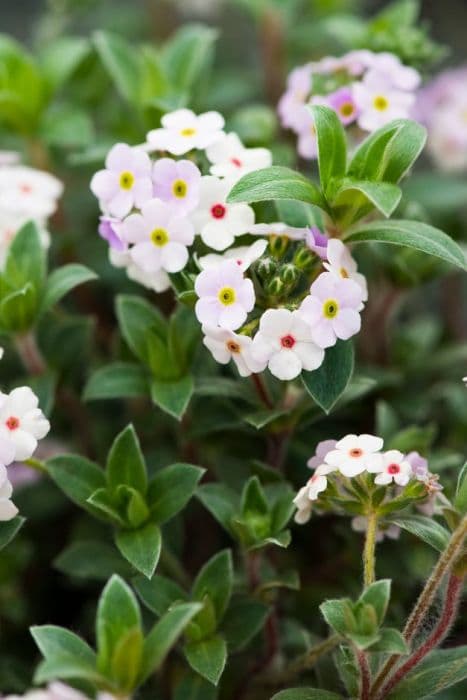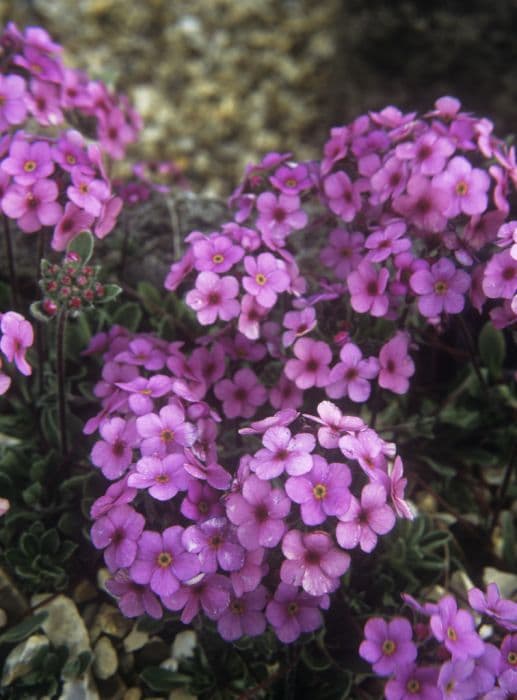Primrose Primula 'Crescendo Pink and Rose Shades' (Crescendo Series) (Pr/poly)

ABOUT
Primula 'Crescendo Pink and Rose Shades', part of the Crescendo Series, is a vibrant and hardy perennial known for its lush and colorful flowers. The plant displays a stunning range of pink and rose-colored blooms, which provide a bright and cheerful expression in the garden. These flowers are typically shaped like an open cup or a rounded bell, creating an inviting display of color. The blossoms are borne atop sturdy stems that rise from a dense rosette of green leaves. The foliage is lush and usually forms a compact clump, contributing to the plant’s overall bushy appearance. The leaves themselves are soft to the touch and may have a somewhat crinkled texture, with a rich green hue that creates a lovely backdrop for the vivid flowers. During its blooming period, this Primula variety transforms any garden space with its shades of pink and rosy hues, presenting a gradient of colors that can range from soft pastels to more intense tones. The captivating color mix adds depth and dimension to the visual appeal of the plant. These lively tones can attract butterflies and hummingbirds, adding to the dynamic life that this plant supports. Overall, Primula 'Crescendo Pink and Rose Shades' exhibits a cheerful and robust presence in the garden, gracing the space with its delightful blossoms that are certain to catch the eye and evoke a sense of springtime enchantment.
About this plant
 Names
NamesSynonyms
English Primrose, Common Primrose, Garden Primrose
Common names
Primula 'Crescendo Pink and Rose Shades'.
 Toxicity
ToxicityTo humans
The common name for Primula 'Crescendo Pink and Rose Shades' is Primrose. Generally, primroses are not considered highly toxic to humans. However, some people may have a sensitivity to the plant that can cause mild irritation or an allergic reaction upon contact with the skin, or gastrointestinal upset if ingested. Symptoms of ingestion may include nausea, vomiting, or diarrhea. Always handle plants with care and avoid ingestion to prevent any potential adverse reactions.
To pets
The common name for Primula 'Crescendo Pink and Rose Shades' is Primrose. Primroses are not highly toxic to pets, but they can cause mild gastrointestinal upset if ingested. Symptoms in pets may include vomiting, diarrhea, or drooling. Contact with the plant can sometimes lead to mild dermatitis in sensitive pets. It is advisable to monitor pets and prevent them from ingesting any parts of the plant to avoid these potential reactions.
 Characteristics
CharacteristicsLife cycle
Perennials
Foliage type
Evergreen
Color of leaves
Green
Flower color
Mixed
Height
6 inches (15 cm)
Spread
8 inches (20 cm)
Plant type
Herb
Hardiness zones
5
Native area
Europe
Benefits
 General Benefits
General Benefits- Vibrant Color Display: Creates a striking visual appeal with its shades of pink and rose.
- Extended Bloom Time: Offers a long flowering season from late winter to early spring, providing color during a time when other plants may not be in bloom.
- Attracts Pollinators: Helps support the ecosystem by attracting butterflies and bees.
- Low Maintenance: Requires minimal care once established, making it suitable for gardeners of all skill levels.
- Cold Tolerant: Hardy in cooler climates, enabling it to survive and even thrive in colder temperatures.
- Versatility in Landscaping: Can be used in a variety of garden settings including borders, containers, and rock gardens.
- Compact Growth: Its relatively small size makes it suitable for planting in tight spaces or as part of a mixed display.
 Medical Properties
Medical PropertiesThis plant is not used for medical purposes.
 Air-purifying Qualities
Air-purifying QualitiesThis plant is not specifically known for air purifying qualities.
 Other Uses
Other Uses- Decorative Ice Cubes: Freeze petals of the primrose in ice cube trays with water to create visually appealing ice cubes for summer drinks.
- Natural Dyes: The colorful petals can be used to produce natural dyes for fabrics or art projects.
- Garden Art: Press primrose flowers to create botanical prints or to use them in crafting personalized garden stationery and bookmarks.
- Table Decor: Scatter fresh primrose petals on tables for spring-themed events or weddings to add a touch of natural beauty.
- Culinary Garnish: Edible varieties of primroses can add a splash of color as garnishes for salads and desserts (ensure the variety is safe for consumption).
- Eco-friendly Confetti: Dry and crush the petals to use as biodegradable confetti for outdoor events.
- Floral Crafts: Use the flowers in homemade potpourri mixes, along with other fragrant herbs and flowers.
- Plant Dye Paint: Extract juices from the primrose petals to use as a natural watercolor paint for artistic endeavors.
- Hair Accessories: Incorporate fresh or dried primrose flowers into hair clips, crowns, and combs for a natural, floral look.
- Homemade Syrup: Infuse sugar syrup with primrose flowers to create a unique flavoring for cocktails, lemonades, or to drizzle over pancakes.
Interesting Facts
 Feng Shui
Feng ShuiThe Primrose is not used in Feng Shui practice.
 Zodiac Sign Compitability
Zodiac Sign CompitabilityThe Primrose is not used in astrology practice.
 Plant Symbolism
Plant Symbolism- Youthful Charm: Primulas often symbolize youthfulness due to their bright and early blooms in the spring, when they are among the first flowers to appear.
- Hope and Positivity: The vibrant colors of the Primula, including the pink and rose shades, bring a sense of optimism and are often associated with the feeling of looking forward towards brighter times.
- Renewal: As spring flowers, they are emblematic of new beginnings and the renewal of nature, symbolizing fresh starts and the cycle of life.
- Love and Romance: The shades of pink and rose naturally connect with feelings of love and affection, making the Primula an emblem of tender feelings and romantic emotions.
- Constancy and Endurance: Some consider the perennial nature of Primulas as a symbol of enduring and everlasting values or relationships.
 Water
WaterPrimroses should be watered regularly to maintain moist soil, as they prefer consistent moisture. For Primula 'Crescendo Pink and Rose Shades', you should provide thorough watering that reaches the root zone without causing water to pool around the base, usually about one inch of water per week. During hot spells or dry seasons, increase the frequency to twice per week, ensuring that the topsoil doesn't dry out completely. It's best to water these plants in the morning to allow foliage to dry out over the course of the day, reducing the risk of fungal diseases.
 Light
LightPrimroses thrive in bright, indirect light, so for Primula 'Crescendo Pink and Rose Shades', a spot that receives dappled sunlight or light partial shade is ideal. Avoid placing them in direct, harsh sunlight, especially during the hottest parts of the day, to prevent scorching of the leaves. An east or north-facing window or a shaded southern exposure can provide the perfect light conditions for these plants when grown indoors.
 Temperature
TemperaturePrimrose plants, including the Primula 'Crescendo Pink and Rose Shades', prefer cooler temperatures ranging between 50 to 70 degrees Fahrenheit. They can survive brief periods outside this range, but temperatures below 50 degrees can cause chilling damage, while temperatures above 80 degrees can stress the plant and impede flowering. The ideal growing conditions include cool nights and mild daytime temperatures.
 Pruning
PruningPrimula 'Crescendo Pink and Rose Shades' benefit from deadheading spent flowers to encourage more blooms and maintain a tidy appearance. Prune away any yellowed or dead leaves to prevent disease and promote air circulation. Pruning is typically done after the main blooming period in early summer, but removing spent flowers can be done as needed throughout the blooming season. The best time for more substantial pruning is late winter or early spring before new growth begins.
 Cleaning
CleaningAs needed
 Soil
SoilThe best soil mix for Primrose 'Crescendo Pink and Rose Shades' is well-draining, humus-rich, and moisture-retentive. A blend of loam, peat, and perlite can provide the right texture and fertility. The soil pH should be slightly acidic to neutral, around 6.0 to 7.0.
 Repotting
RepottingPrimrose 'Crescendo Pink and Rose Shades' should be repotted annually, usually after flowering. Repotting helps refresh the soil and provides space for growing roots, ensuring the plant remains healthy.
 Humidity & Misting
Humidity & MistingPrimrose 'Crescendo Pink and Rose Shades' thrives in conditions with moderate to high humidity. Aim to maintain humidity levels around 50% to 60% for optimal growth.
 Suitable locations
Suitable locationsIndoor
Keep in bright, indirect light, with moist soil and cool temperatures.
Outdoor
Plant in partial shade, with moist, well-drained soil, shelter from wind.
Hardiness zone
4-8 USDA
 Life cycle
Life cycleThe Primula 'Crescendo Pink and Rose Shades', commonly known as Polyanthus Primrose, begins its life cycle from seeds which germinate in cool conditions, often requiring a period of cold stratification to break dormancy. The seedlings develop into a rosette of leaves, establishing a root system before sending up flowering stems. During the flowering period in late winter to spring, the plant produces clusters of pink and rose-colored flowers, attracting pollinators for sexual reproduction and seed development. After pollination, the plant sets seed, which can be collected once the seed capsules dry and then sown for the next generation of plants. The Polyanthus Primrose may enter a dormancy stage during the hot summer months, conserving energy for the next flowering season. With proper care and favorable conditions, this perennial can last through several seasons, though it may also be grown as an annual in some climates.
 Propogation
PropogationPropogation time
Spring to Summer
Primula 'Crescendo Pink and Rose Shades', commonly known as Primrose, is typically propagated by seed as it is the most popular method. Sowing should be done in late winter to early spring to allow the plant time to grow and establish itself before the colder months. Seeds are lightly sprinkled onto a tray filled with a well-draining seed starting mix and gently pressed into the soil, but not covered, as primrose seeds need light to germinate. The tray is then moistened and placed in a bright, warm location away from direct sunlight, with a consistent temperature of around 60-70°F (15-21°C), to promote germination. It is important to keep the soil consistently moist but not waterlogged. Germination usually occurs within 2 to 3 weeks, and after the seedlings have developed a couple of true leaves, they can be transplanted into individual pots.









